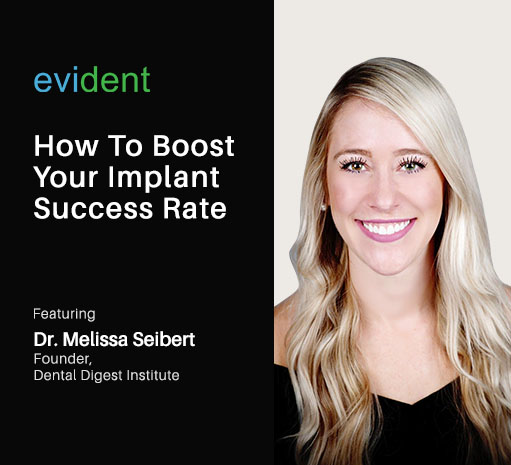

The process of planning and implementing dental implants is one that requires careful consideration. Merging a patient’s organic tissue and even the most carefully crafted dental implant is a tricky process.
There are so many touchpoints of the workflow that can go awry, from planning to the recovery phase. Because it is such a meticulous pipeline, the implementation of digital workflows is a crucial addition that can mean the difference between implant success or failure.
When learning more about how to boost implant success rate, finding the right sources and experts to gain knowledge from is the necessary groundwork to lay in executing a more effective dental implant workflow.
In this episode of the Evident Digital Dentist Series, we were joined by Dr. Melissa Seibert, to discuss how to do just that.
She is the founder of the Dental Digest Podcast and among the Top 40 Under 40 Dentists in America, as well as a clinician for the US Air Force. As a self-proclaimed dental nerd, in this episode she passionately shared her expertise on effectively planning and implementing dental implants, as well as the major improvements that digital workflows can make throughout the pipeline.
Experience in Dentistry
After her dental studies at the University of Louisville, Dr. Melissa pursued further training. She completed a one-year AGD in Louisiana, followed by a two-year comprehensive Advanced Education General Dentistry residency.
She then began practicing comprehensively. Her work includes orthodontics, full digital workflows, implant planning, and aesthetic dentistry.
Despite her extensive training, she noticed a problem. Like her, many dental school graduates felt ill-prepared for real-world dental practice. This was particularly true given the increasing complexity of the industry.
To address this issue, Dr. Melissa founded the Dental Digest podcast. It focuses on evidence-based dentistry and helps dentists stay updated.
She noticed a rising popularity in continued dental education courses. In response, she began publishing episodes every Monday. These episodes help dentists navigate the vast amount of dental information in the digital age.
In her podcast, Dr. Melissa covers a wide range of topics relevant to dentistry. These include dental CAD/CAM, composite restorations, and techniques to improve case acceptance rates.
The Crucial First Step in Implant Planning
Of course, Dr. Melissa’s expertise includes successful implant procedures. Whether she’s placing or restoring an implant, she emphasizes the critical importance of an initial case assessment.
A major preliminary measure would be assessing the patient’s periodontal health and the necessary considerations throughout the case. While it is possible to place implants in patients with periodontal disease, stabilizing their periodontal health beforehand is vital for long-term success.
Another crucial factor is the presence of adequate keratinized tissue around the implants. Dr. Melissa highlights that having keratinized tissue facilitates better oral hygiene practices for patients. She also carefully measures the distance from vital structures such as nerves and sinuses, ensuring a safe and successful implant placement.
Careful planning and precise placement ensure the avoidance of potential complications.
Dr. Melissa also discusses the optimal spacing between implants and adjacent teeth. To achieve an ideal fit, a distance of 1.5 millimeters from adjacent teeth and 3 millimeters from adjacent implants is recommended. This consideration allows for a proper emergence profile and facilitates effective cleaning.
When it comes to occlusion, Dr. Melissa explains that heavy occlusion on implants is not recommended. Instead, she recommends focusing on a balance that minimizes excessive force on the implants. Proper evaluation and adjustment of occlusion are crucial for long-term success.
Regarding marginal placement, Dr. Melissa advises placing implant margins at or slightly subgingival to promote gingival health and aesthetics. Supra-gingival placement may be easier for surgical access. However, it can lead to more challenging oral hygiene maintenance and potential esthetic issues.
Correct implant planning extends beyond just installation. It involves considering the implant’s long-term benefits and impacts on the patient.
Implant Planning and Digital Workflows
With all these considerations in place, Dr. Melissa continued to discuss the implant planning phase and how digitization helps to streamline the process. Digital workflows have revolutionized the field of dentistry, particularly in implant planning and placement.
By leveraging digital tools, dentists can enhance precision, accuracy, and predictability in otherwise tentative implant procedures. Digital implant planning allows for meticulous evaluation of the aforementioned considerations during the assessment phase.
This digital planning of course begins with the scanning process in order to get more detailed data on the case. Dr. Melissa acknowledges the rapid evolution of scanning technology, making it challenging for peer-reviewed literature to keep pace.
If you delay your decision to buy a scanner until peer-reviewed literature is published, there’s a risk. The technology of that specific scanner might be outdated by the time it gets published.
Regardless, she emphasizes the availability of several high-quality dental scanners in the market that offer accurate digital planning capabilities. By utilizing digital scans and STL (standard tessellation language) files, dentists can visualize and align implant placement with the patient’s smile.
Dr. Melissa also discussed the importance of having a high-quality cone-beam computed tomography (CBCT) scan to overlay the digital planning with clinical knowledge and experience. She emphasized that traditional impressions are becoming obsolete, as digital scanning offers greater accuracy and convenience. By digitally aligning the proposed implant position with the patient’s smile dentists can expect a more predictable and satisfactory outcome.
Once the scans are complete and the planning process is done, digital workflows remain highly valuable. They play a key role in creating the actual dental products.
Dentists can offer patients more accurate implants through digital design and 3D printing or milling. These require fewer adjustments during installation. Digital wax ups serve as excellent patient education tools too. They can help increase case acceptance rates. As a result, dentists can provide the high-quality care their patients require.
Boosting Your Implant Success Rate
Implant planning is such a complex process that might be difficult to perform successfully using traditionally analog processes. However, with the advent of advanced techniques and digital transformation, the field has evolved. Now, even the most complex cases are managed more efficiently.
Dr. Melissa and her peers have proven digital dentistry works. By staying updated and embracing progress in their field, dentists significantly improve their implant success rates. This proactive approach not only benefits the dentists, but their patients as well. They can now enjoy durable, functional, and aesthetically pleasing dental implants.
Evident Digital is fueled by a passion to bring the future of dentistry to life. We collaborate with dentists and practices, big or small, to make this dream a reality. As your dedicated partner, we’re committed to excellence in the digital services we provide.
Evident is your one-stop shop for your digital dentistry needs. From lab management and secure data storage to digital design services, we cover all your needs. Our mission? To supercharge the efficiency and growth of your practice with the best of digital dentistry.
Discover more about how Evident Digital can empower your practice today.









